
Attachment to a community is an important factor in where we choose to live. An interesting US survey by Knight Foundation and Gallop highlighted the three most
important factors for community
(in ranked order):
- Social Offerings – meeting places, nightlife, arts & cultural opportunities, community events, and general connectedness and the feeling of caring within the community
- Openness – how welcoming a community is to all participants
- Aesthetics – the overall beauty of the community space including access to parks
Across a very broad spectrum of people and locations these three factors ranked the highest, with Social Offerings ranking #1 consistently. Attachment was found to be more strongly related to perceptions about the community than to the demographics within the community itself. The full report is available through SouloftheCommunity.org.
These findings support the drive behind the urban planning approach of “place making”, creating public spaces and buildings that support community activities and engagement opportunities. Initiatives like Project for Public Spaces encourage public realm improvements that foster a sense of community. Creating cultural interaction within a neighborhood drives a sense of community and attachment to that community, which in turn foster growth and development within that community.
“Placemaking is a multi-faceted approach to the planning, design and management of public spaces. Put simply, it involves looking at, listening to, and asking questions of the people who live, work and play in a particular space, to discover their needs and aspirations. This information is then used to create a common vision for that place.”[1]
With the success of a community being driven by a sense of belonging and opportunities for engagement, resulting in a better local economy, it is in the interest of developers to create public spaces that encourage community and a sense of place. A strong community that attracts people means higher residential prices, higher commercial prices and more demand for the community.
Community is place driven, but not always living location driven. Successful communities in the inner-city can have a significant ‘artificial community’ for non-residents. Consider where you prefer to shop/eat/walk/interact. For many that work in downtown Calgary, inner-city communities represent way-point stops on the way home or after work for social interaction that is not afforded in the suburbs. Notably absent from subdivisions are the bustling, busy, retail dense ‘main streets’ that reflect competing restaurants and retailers that attract people to opportunities for choice in eating, shopping and social interaction. The ‘commercial hub’ approach to commercial development often still only affords one or two choices for shopping/groceries/eating places within the hub.
Inviting community interaction when developing a building and the adjacent public accessed spaces fosters community connectives and creates positive community ties with a view to placemaking and the fostering of community attachment. The financial reward of vibrant communities speak for themselves: thriving communities command higher retail and commercial lease rates and residential sale prices.
Resources:
An Explanation of Community Attachment – Soul of the Community Project
